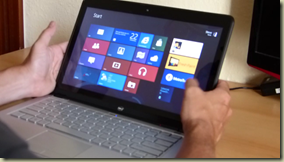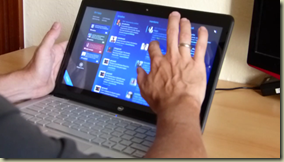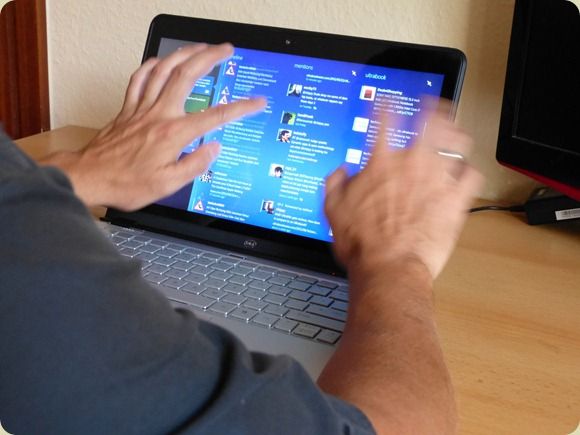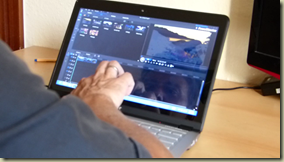You’ll see this touchscreen Ultrabook used extensively over the next month or so as I explore and demonstrate software and operating system elements. In this video I want to answer one of the most often asked questions – why have a touchscreen on a laptop when your hands need to be near the mouse and keyboard?
I’ve been using touchscreen devices since 2007. For over 1 year I used a touchscreen netbook as my only laptop, It was running Windows XP (not tablet edition) and had a resistive touchscreen. Even with all those limitations there were scenarios where I found using touch to be an advantage. Sometimes it’s not natural but sometimes it’s worth it.
There are two videos below. The first shows a true made-for-touch experience. Fruit Ninja works well and with the large-screen multitouch and no need to hold the device in a hand, easier than on a tablet. This scenario is one of three touch scenarios you’ll find yourself in with a touch Ultrabook and I demonstrate all three in the second video.
Scenario 1 – Easy Touch
 Windows 8 ‘Metro’ UI works in a very natural mode and when consuming, is actually very relaxing, fun and productive setup.The two hands wrap around each side of the screen and the thumb and forefinger become the main controllers.
Windows 8 ‘Metro’ UI works in a very natural mode and when consuming, is actually very relaxing, fun and productive setup.The two hands wrap around each side of the screen and the thumb and forefinger become the main controllers.
Scenario 2 – Center Screen Working (Sub-Optimal)
 This is less natural and it’s going to be difficult to convince many people that this is a good way of working. I use it but only for scenarios where it makes sense. In some Metro apps where touch control extends into the middle of the screen it’s not that nice. Take Metro Twit. The center scrolling column requires some hand movement. It would be better if the columns were changed to rows and could be controlled from the sides.
This is less natural and it’s going to be difficult to convince many people that this is a good way of working. I use it but only for scenarios where it makes sense. In some Metro apps where touch control extends into the middle of the screen it’s not that nice. Take Metro Twit. The center scrolling column requires some hand movement. It would be better if the columns were changed to rows and could be controlled from the sides.
Scenario 3 – Center Screen with Benefits
This is your productive touch scenario and it requires a solid screen and some practice. It’s a scenario where you commit to getting the hands moving in the name of productivity. In scenario 2 there are times when having to move the hand to the center of the screen for one swipe is awkward. The difference in scenario 3 is that you’re getting benefits by getting touchy. The same scenario applies to touch-driven games and other touch-focused applications like painting. It’s this scenario that is the hardest to convince people of and the hardest to learn. Once you get to this stage though, you’ll find yourself touch monitors and laptop screens without thinking about it. Personally I’ve gone a bit beyond this stage and can get benefits by driving the desktop with my fingers – an application that isn’t really tailored towards fingers. Many of you that have had TabletPCs in the past will know about this stage.
The Videos
Again, the first video is a dedicated touch game. The second video demonstrates the three scenarios I mention above. If you have experience and thoughts or you have questions or want to see something else demonstrated, comment below.













This site and your work; brilliant. Also this article really adresses some of my pessimism toward touchscreen on laptops. Cool.
Also constructive critisism towards your site:
While awesome and alone in ultrabooknews on the net. Your site could use some upgrades on design and userfriendlyness when browsing ultrabook lists. The design is a bit dull and it is sometimes confusing to find ultrabooks in you library.
Forgive me for my bad english/harsh comments as english is my second language.
But again good articles and up-to-date ultrabooknews.
Very happy to have feedback.
There are a number of things I want to do with the product database but haven’t had the time/money over the years. If you could put some ideas into the contact form,I would appreciate it.
Steve/Chippy
I don’t know. Both of the good scenarios, 1 and 3, don’t seem to be better than just using the mouse or multi-touch trackpad.
For scenario 1, you could show how to do the same things with the trackpad too. That way readers/viewers can see if touch actually provides a benefit or a large enough advantage that’s worth the investment. From what I’ve seen, Microsoft didn’t throw away the mouse in favor of touch when designing the Metro UI.
For scenario 3, the examples you showed didn’t look like they would be easier with touch than with a mouse (ie. dragging, moving, etc.). Even for zooming in and out, a well designed app will let you use something like ctrl+scroll or the same pinch action on the trackpad to zoom in/out areas under the mouse pointer or just some simple zoom buttons. It might even be easier than trying to pinch 2 fingers in that small area.
Scenario 2 would be the case where my arm would get tired and stiff after a few minutes.
The way I see it, there are some benefits to touch but not really worth the extra cost for many consumers provided that app developers put effort in designing their app well (ie. intended to be used with either a mouse or touch).
Thank you for the Win 8 usage and insights. What size screen did you run the demo on?
I read that Win 8 will redefine laptops/ultrabooks because laptop hinges are not strong enough to support long term use of touch. This suggests that future Win 8 devices will either be convertible laptops or tablets with keyboard docks. The second option appeals to me with the option of leaving the dock weight behind and in cramp spaces you would only use a tablet/screen anyway. What do you think?
I do want to buy a “Win8 device” to replace my netbook that died a couple of months ago. I am currently using my deadweight laptop! Should I skip the first gen of Win 8 devices (Ivy Bridge) and wait for the second gen of Win 8 devices (Haskell) when the ideal Win 8 device is better defined?
I see more of a future for convertible notebooks or dockable tablets than traditional notebooks with a touchscreen. These videos didn’t really make touch on a clamshell notebook look that appealing when used on a table.
I agree that touch mostly shines in situations where a desk or a large enough space isn’t available. For example, cramped airplane seats, standing, lazy couch usage, etc. Other than inking and drawing, I mostly see touch input as a fallback control to a mouse and keyboard.
Who knows when’s a good time to buy a Windows 8 device. When the first gen devices come out there could be talk about the next big feature of the next gen. For me, I’ll probably wait a year before using Windows 8 beyond a virtual machine.
I agree, convertible notebooks (twisting screen, sliders, flipping screen, etc) and dockable tablets are more likely to be successful Windows 8 devices than an ultrabook with a touch panel slapped on.
Anyway, this is just a reference design and I’m hoping companies will not just go with adding touchscreens to ultrabooks and calling it a day.
Love the videos! Great demo of Win8 plus touch,
Touch screen is nice. But imagine using the
screen with touch and keyboard and you end
up with lots of smudges on your screen. Try
looking at a screen with so many finger marks
and its annoying and reduces clarity. Touch
screen is good but should be handled with
clean fingers, and as you know a lot don’t
have time nor the effort to keep their hands
clean just to touch the screen.
“Hover doesn’t work with touchscreens, etc.”
Well of course it doesn’t work. As well as many other use cases. Why ? Because it’s a fracking notebook, not a tablet. Just because Micro$h!t thought it was a great idea to cramp both UI’s on devices that are not supposed to even have them, doesn’t mean you have to follow their idiotic philosophy and buy their crap.
People need to understand there are 2 different categories. 1 for productivity, 1 for media consumption. You can’t just combine them into an abomination and hope for the best. That’s idiotic.
But if you really want to buy a $800 device and fill its screen up with finger smudges from the first day you buy it, then fine, just go ahead. I find it to be a very stupid idea.
Really not convinced that any of the scenarios make touch look preferable to keyboard and mouse. And on a larger screen the issues with not being able to reach the centre readily would become more pronounced. On a raised desktop PC screen they’d be particularly bad since you’d need to lift your hands.
It looks like a shiny screen on your ultrabook, and the Asus UX21 model with touch (not yet released) also has a shiny screen. Will touch screens remain shiny, or will manufacturers combine touch with the more productive matte screens? In any case fingerprints could be an issue and fingers obstruct your view.
A better design for Windows 8 would have been for it to detect the device type and configure itself for primarily mouse and keyboard or primarily touch, or to offer the user the choice to configure it either way. Touch is a nice addition to any computer but I don’t see it as a good primary means of interaction on productivity machines.
The Thinkpad X230t convertible tablet has either a matte or glossy screen. The videos I’ve seen for the 11.6″ Acer S7 showed a matte touchscreen. The 13.3″ S7 had a glossy screen though.
Windows 8 is designed to be used with either a mouse or finger without any special configuration. It seems Microsoft did fairly well in implementing both input methods for their OS. 3rd party software, on the other hand, may or may not be designed as well.
Anyway, I agree that touch is a nice secondary input but certainly not a good primary one in most usage scenarios. Even more so for a notebook form factor.
Depends on the notebook form factor, touch is certainly easier to use on a notebook than a desktop, especially on the smaller notebooks.
While touch can be easily swapped for a touchpad or motion control. Either preventing the need to reach for the screen and extends usefulness to situations like controlling the system from one’s living room couch for example, for those with entertainment setups.
Mind we’re going to be seeing a lot more convertible and hybrids as well and not just systems with touch screens added.
I’m not convinced either. The ergonomics look horrible in all of those cases. So far I haven’t seen anything that couldn’t be handled more efficiently with mouse gestures and keyboard shortcuts.
A calculator. Ever tried using that with a mouse?